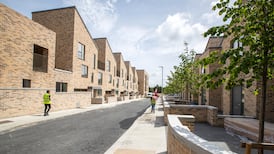The Dundrum Local Area Plan (LAP) sets out a framework for future development in the area from Dundrum village and the town centre shopping complex in the south, to the former central mental hospital and Dundrum Business Park in the north.
Dundrum in south Dublin, while referred to as a village, is the second “Major Town Centre” in the Dún Laoghaire-Rathdown County Council area, after the county town. The entire local authority area is governed by the county development plan, but the need for a more specific, detailed LAP was identified by the council back in 2016 due the number of large sites likely to come under pressure for residential development coming out of the recession.
In 2018 the council began the “pre-draft” process for the plan, but since then, development has galloped on and many of the sites identified for large-scale apartment schemes have already entered the planning process, with some, most notably the mental hospital site, out the other side with permission, without the benefit of the guiding hand of the LAP.
[ Frank McDonald: Dundrum scheme’s overwhelming scale an indictment of the systemOpens in new window ]
[ Over 700 objections lodged against €466m Dundrum apartment ‘concrete jungle’Opens in new window ]
The population of the area covered by the LAP is going to grow, massively, from about 6,500 residents at present to potentially 11,500 with more than 2,000 new homes, mostly apartments, planned. While the council may have missed the opportunity to use the LAP to guide the structure of some of these new residential sites, where it can still have a significant influence is in how the growing number of new residents affect Dundrum, most particularly in how they get around and out of the town.
RM Block
In terms of transport, the LAP is upfront about what it is trying to achieve. It is rooted in the 10-minute town concept, where essential daily services are all within a 10-minute walk, cycle, or public transport journey, and in making interventions to “encourage” people not to use cars for their trips where possible.
Dundrum has a major asset in the Luas, albeit a service under capacity strain, and also has a significant population already within short walking distance of facilities such as shops and schools. However, the private car is still the dominant means of transport and the main street has a significant problem with “through traffic” avoiding the Dundrum bypass.
The council’s transport assessment found it likely that cars were regularly used for “discretionary trip making” with half of trips of less than 2km taken by car. All residents are within a 10-minute cycle of their nearest school, and the majority of residents within a 15-minute walk, it said.
[ Proprosed ‘gigantic’ Dundrum development is out of scale, meeting hearsOpens in new window ]
During the Covid-19 pandemic a one-way northbound system, with southbound cycle lanes, was introduced along most of Main Street. This intervention “significantly improved the urban realm and provided a better environment for walking and cycling”, the LAP states. “However, other parts of the network have quite narrow footpaths and limited crossing facilities”.
The LAP proposes retaining and extending the Main Street one-way system, introducing a similar one-way system on Sydenham Road and improving cycle infrastructure on the bypass. Cycling infrastructure will be introduced on a number of other roads, and pedestrian facilities will be improved, particularly at junctions. Bus gates that restrict vehicular traffic to buses, taxis and emergency vehicles only, will be introduced at Dundrum Cross, stopping traffic coming from Ballinteer Road and Barton Road East from turning left on to Main Street; and at a small section running from Main Street to Sweetmount Avenue, which is inaccessible to any vehicles.
Crucially, no parts of Dundrum will be made inaccessible by car, and entry to all car parks will be maintained. What the LAP will do, is make it less convenient to use cars, and make sustainable transport more attractive. This, the council has made clear, is essential if Dundrum is to cope with the expected population growth, and if the village centre is to survive.
The plan is available for public consultation and submissions until Friday, July 21st.











